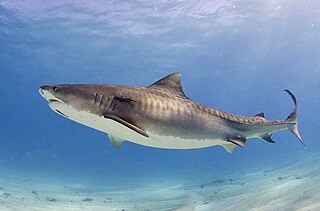
Galeocerdo is a genus of ground shark. Only a single species, G. cuvier, the tiger shark is extant. The earliest fossils date back to the early Eocene epoch, (Ypresian), around 56–47.8 Million years ago. While historically considered a member of the requiem shark family Carcharhinidae, it is currently considered to be the only member of the family Galeocerdonidae. While this genus was historically considered diverse, including 21 extinct species, morphometric analysis conducted in 2021 suggested that the diversity of the genus included only 5 extinct species much lower than previously assumed. The oldest fossils of the extant G. cuvier date to the middle Miocene.

The rugosa, also called the tetracorallia or horn coral, are an extinct order of solitary and colonial corals that were abundant in Middle Ordovician to Late Permian seas.

Rail transport in Lithuania consists of freight shipments and passenger services. The construction of the first railway line in Lithuania began in 1859. As of 2021, the total length of railways in Lithuania was 1,868.8 km (1,161.2 mi). Lietuvos Geležinkeliai, the national state-owned railway company, operates most of the passenger and freight services.

Rail Baltica is a greenfield rail transport infrastructure project underway, with a goal to integrate the Baltic states in the European rail network. Its purpose is to provide passenger and freight service between participating countries and improve rail connections between Central and Northern Europe, specifically the area southeast of the Baltic Sea. Furthermore, it is intended to be a catalyst for building the economic corridor in Northeastern Europe. The project envisages a continuous rail link from Tallinn (Estonia) to Warsaw (Poland), consisting of links via Riga (Latvia), Kaunas, and Vilnius (Lithuania). Its total length in the Baltic States is 870 kilometres (540 mi), with 213 kilometres (132 mi) in Estonia, 265 kilometres (165 mi) in Latvia, and 392 kilometres (244 mi) in Lithuania. Rail Baltica is one of the priority projects of the European Union (EU). It is part of the North Sea–Baltic Corridor of the Trans-European Transport Networks (TEN-T).
Ganorhynchus is an extinct genus of prehistoric lungfish from the Devonian period. It is only found in Mansfield, Pennsylvania.

Glyptolepis is an extinct genus of porolepiform lobe-finned fish which lived during Devonian Period, from the early Eifelian to Frasnian Age. Species include Glyptolepis baltica.
Branchierpeton is an extinct genus of dissorophoidean euskelian temnospondyl within the family Micromelerpetontidae native to Africa.
Batrachosuchoides is an extinct genus of prehistoric amphibian from the Early Triassic of Russia. It was found in the Baskunchakskaia Series and the Lestanshorskaya Svita.
Batrachosaurus is an extinct genus of prehistoric brachyopoid amphibian that lived in Germany during the Middle Triassic (Ladinian). The genus was named by Joseph Fitzinger in 1837 and the type species, B. jaegeri, was named three years later in 1840. It may have been the same animal as Mastodonsaurus.

The Social Democratic Party "Harmony", also commonly referred to as Harmony (Saskaņa), is a social-democratic political party in Latvia. It was the largest political party in the Saeima, representing the Russian minority of Latvia, before losing all of its parliamentary seats in the 2022 Latvian parliamentary election. It is currently led by Jānis Urbanovičs.

Chelonoidis is a genus of turtles in the tortoise family erected by Leopold Fitzinger in 1835. They are found in South America and the Galápagos Islands, and formerly had a wide distribution in the West Indies.

The Gauja Formation is a Middle Devonian fossil locality in Estonia and Latvia. It is named after the Gauja River, where it is exposed along the banks.

Geragnostus is a genus of very small agnostid trilobites whose fossils are found Ordovician-aged marine strata from Eurasia, North America and Argentina.
The Hedmark Group is a geologic group that outcrops in Innlandet, Norway. It preserves microfossils of Neoproterozoic age.

Hippohyini was an extinct tribe of Suinae which existed in Asia during the Pliocene.

Hyotheriinae was a subfamily of even-toed ungulates that existed during the Miocene and Pliocene in Europe, Asia, and Africa.
Angochitina is an extinct genus of chitinozoans. It was described by Alfred Eisenack in 1931.
Xhosacetus is a genus of ziphiid cetaceans with a single species, Xhosacetus hendeysi. It was classified from fossils found off the coast of the Kerguelen islands in 1,145 meter deep water.

Dactylorhiza majalis subsp. baltica is a subspecies of Dactylorhiza majalis. Sometimes, this plant is considered as a species: Dactylorhiza baltica.

Sphodrosaurus is an extinct genus of basal archosauriformn reptiles from the Late Triassic-aged New Oxford Formation of Pennsylvania. The type species is S. pennsylvanicus, described by Edwin Colbert in 1960. The holotype consists of a partial skeleton including the back of the skull, the vertebral column, all of the ribs, all of the hindlimbs and part of the upper forelimbs; Sphodrosaurus was originally believed to have been a member of the Procolophonidae while more recently Sphodrosaurus was believed to be a basal member of the Diapsida by most authors starting with Sues et al. (1993), or a member of the Rhynchosauria. In 2022, Ezcurra & Sues redescribed the holotype in detail and placed it in a phylogenetic analysis with other Triassic diapsid reptiles, where it was found as the basalmost doswellid.












